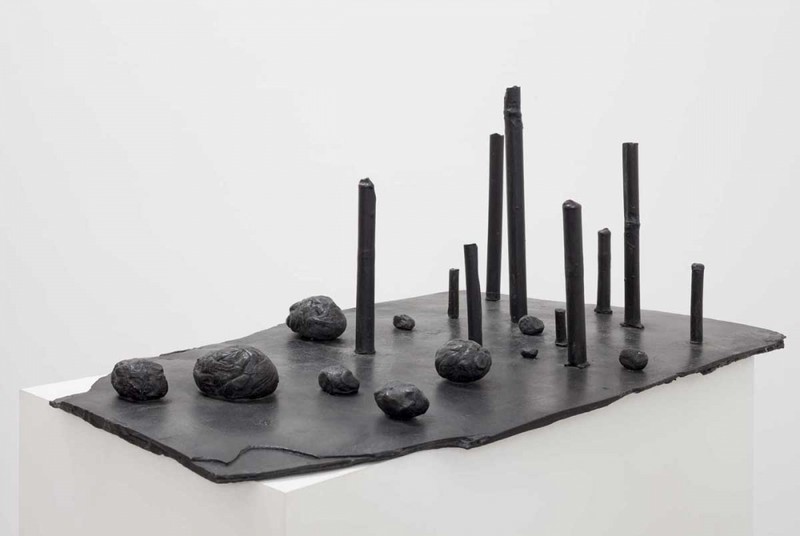João Maria Gusmão + Pedro Paiva
10 Aug - 14 Sep 2013

João Maria Gusmão + Pedro Paiva
Teorema de Eratóstenes, 2013
Bronze
34,5 x 89 x 60 cm
Photo: Eduardo Ortega
Teorema de Eratóstenes, 2013
Bronze
34,5 x 89 x 60 cm
Photo: Eduardo Ortega
JOÃO MARIA GUSMÃO + PEDRO PAIVA
O Problema de Molyneux
10 August - 14 September 2013
O problema de Molyneux [Molyneux’s Problem] is artist duo João Maria Gusmão and Pedro Paiva’s second solo show in São Paulo. Highlighted at this year’s Venice Biennale, the artists are presenting photographs, bronze sculptures and 16mm films, all of which are recent or new works.
Gusmão and Paiva explore references of existentialism in the philosophical tradition, metaphysical literature, as well as Alfred Jarry’s proto-surrealism. The exhibition takes its title from a philosophical question proposed by William Molyneux to John Locke about the recovery of sight. If a man born blind can feel the differences between shapes such as spheres and cubes, could he similarly distinguish those objects by sight if given the ability to see? This problem is mentioned by Locke in his An Essay Concerning Human Understanding, regarding the basis of knowledge and the mechanisms of thought in the human mind.
In the first room of the exhibition, eight bronze sculptures propose alegories on the nature of images, optical illusions and physical phenomena. In Coisas Redondas [Round Things], a series of circular objects are connected in such a way that they look square from certain angles. Bola de tênis [Tennis Ball] reproduces the movement of a little ball bouncing on a pedestal. Cavaleiro [Horseman] is a distorted image that creates an illusion of tridimensionality from a determined point of view. By alluding with humor to the language of science, these objects reveal the narrative nature of science and philosophy in their attempts to understand the world.
The second room of the exhibition has been transformed into a large projection room with five short 16mm films. The sequences are shown in loop on a large screen. Three suns setting among stones, a blind man devouring a papaya, and geometricized fruits whirling in the air as though they were a planetary system. The noise of the projector – the films have no sound – is a permanent reminder of the materiality of the images.
João Maria Gusmão (Lisbon, 1979) and Pedro Paiva (Lisbon, 1978) have been working together on the creation of objects, installations and films and 16mm and 35mm format since 2001. They have taken part in various art biennials including the 8th Gwangju Biennial, South Korea, 2010; the 53rd Venice Biennale, 2009, at which they represented Portugal; the 6th Bienal do Mercosul, Brazil, 2007; and the 27th Bienal de São Paulo, Brazil, 2006. Their solo shows have most notably included, in 2011, Alien Theory, at Frac Île-de-France, Le Plateau, Paris, There’s nothing more to tell because this is small, as is every fecundation, at the Museo Marino Marini, Florence, and Tem gwef tem gwef dr rr rr at the Kunsthalle Dusseldorf; and, in 2010, On the Movement of the Fried Egg and Other Astronomical Bodies, at Ikon Gallery, Birmingham.
O Problema de Molyneux
10 August - 14 September 2013
O problema de Molyneux [Molyneux’s Problem] is artist duo João Maria Gusmão and Pedro Paiva’s second solo show in São Paulo. Highlighted at this year’s Venice Biennale, the artists are presenting photographs, bronze sculptures and 16mm films, all of which are recent or new works.
Gusmão and Paiva explore references of existentialism in the philosophical tradition, metaphysical literature, as well as Alfred Jarry’s proto-surrealism. The exhibition takes its title from a philosophical question proposed by William Molyneux to John Locke about the recovery of sight. If a man born blind can feel the differences between shapes such as spheres and cubes, could he similarly distinguish those objects by sight if given the ability to see? This problem is mentioned by Locke in his An Essay Concerning Human Understanding, regarding the basis of knowledge and the mechanisms of thought in the human mind.
In the first room of the exhibition, eight bronze sculptures propose alegories on the nature of images, optical illusions and physical phenomena. In Coisas Redondas [Round Things], a series of circular objects are connected in such a way that they look square from certain angles. Bola de tênis [Tennis Ball] reproduces the movement of a little ball bouncing on a pedestal. Cavaleiro [Horseman] is a distorted image that creates an illusion of tridimensionality from a determined point of view. By alluding with humor to the language of science, these objects reveal the narrative nature of science and philosophy in their attempts to understand the world.
The second room of the exhibition has been transformed into a large projection room with five short 16mm films. The sequences are shown in loop on a large screen. Three suns setting among stones, a blind man devouring a papaya, and geometricized fruits whirling in the air as though they were a planetary system. The noise of the projector – the films have no sound – is a permanent reminder of the materiality of the images.
João Maria Gusmão (Lisbon, 1979) and Pedro Paiva (Lisbon, 1978) have been working together on the creation of objects, installations and films and 16mm and 35mm format since 2001. They have taken part in various art biennials including the 8th Gwangju Biennial, South Korea, 2010; the 53rd Venice Biennale, 2009, at which they represented Portugal; the 6th Bienal do Mercosul, Brazil, 2007; and the 27th Bienal de São Paulo, Brazil, 2006. Their solo shows have most notably included, in 2011, Alien Theory, at Frac Île-de-France, Le Plateau, Paris, There’s nothing more to tell because this is small, as is every fecundation, at the Museo Marino Marini, Florence, and Tem gwef tem gwef dr rr rr at the Kunsthalle Dusseldorf; and, in 2010, On the Movement of the Fried Egg and Other Astronomical Bodies, at Ikon Gallery, Birmingham.
